Yamaha GRIZZLY 700 FI Manual
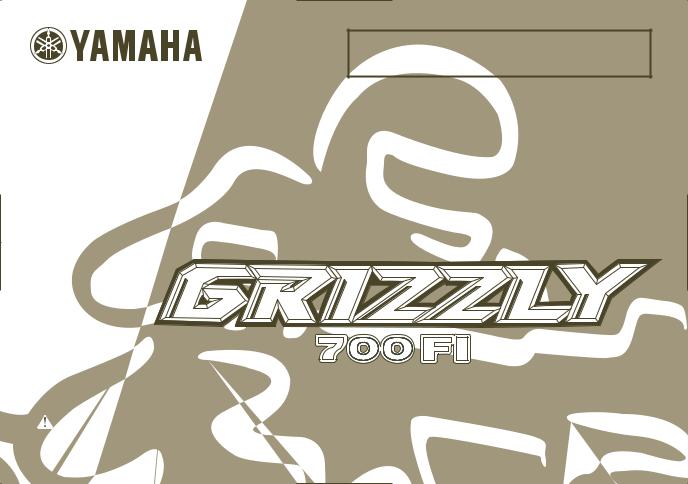
READ THIS MANUAL CAREFULLY!
It contains important safety information.
OWNER’S MANUAL
YFM7FGPW
WARNING |
This ATV should not be ridden by anyone under 16 years of age. |
LIT-11626-20-11 |
3B4-28199-10 |
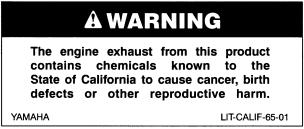
EBU17091
EBU17170
INTRODUCTION
EBU17270
Congratulations on your purchase of the Yamaha YFM7FGPW. This ATV represents the result of many years of Yamaha experience in the production of fine sporting, touring, and pace-setting racing machines. With the purchase of this Yamaha, you can now appreciate the high degree of craftsmanship and reliability that have made Yamaha a leader in these fields.
This manual will provide you with a good basic understanding of the features and operation of this ATV.
This manual includes important safety information. It provides information about special techniques and skills necessary to ride the ATV. It also includes basic maintenance and inspection procedures. If you have any questions regarding the operation or maintenance of your ATV, please consult a Yamaha dealer.
AN IMPORTANT SAFETY MESSAGE:
●READ THIS MANUAL TOGETHER WITH TIPS FOR THE ATV RIDER CAREFULLY AND COMPLETELY BEFORE OPERATING YOUR ATV. MAKE SURE YOU UNDERSTAND ALL INSTRUCTIONS.
●PAY CLOSE ATTENTION TO THE WARNING AND CAUTION LABELS ON THE ATV.
●NEVER OPERATE AN ATV WITHOUT PROPER TRAINING OR INSTRUCTION. FREE TRAINING IS AVAILABLE TO ANYONE WHO BUYS A NEW ATV. CALL 1-800-887-2887 FOR MORE INFORMATION.
●THIS ATV, AND ANY OTHER ATV OVER 90 cc, SHOULD NOT BE RIDDEN BY ANYONE UNDER 16 YEARS OF AGE.

EBU17330
IMPORTANT MANUAL INFORMATION
EBU17341
FAILURE TO FOLLOW THE WARNINGS CONTAINED IN THIS MANUAL CAN RESULT IN SERIOUS INJURY OR DEATH.
Particularly important information is distinguished in this manual by the following notations:
The Safety Alert Symbol means ATTENTION! BECOME ALERT! YOUR
SAFETY IS INVOLVED!
|
|
|
|
Failure to follow WARNING instructions could result in severe injury |
|
WARNING |
|
or death to the ATV operator, a bystander, or a person inspecting or |
|
|
|
|
|
repairing the ATV. |
|
|
|
|
|
|
|
|
|
|
|
|
|
|
A CAUTION indicates special precautions that must be taken to avoid |
|
CAUTION: |
|
|
|
|
|
damage to the ATV. |
||
|
|
|
|
|
|
|
|
|
|
|
|
|
|
|
|
NOTE: |
A NOTE provides key information to make procedures easier or clearer. |
||
|
|
|
|
|
* Product and specifications are subject to change without notice.

EBU17350
IMPORTANT NOTICE
EBU17360
Welcome to the Yamaha world of motor sports!
This ATV is designed and manufactured for OFF-ROAD use only. It is illegal and unsafe to operate this ATV on any public street, road or highway.
This ATV complies with all applicable OFF-ROAD noise level and spark arrester laws and regulations in effect at the time of manufacture.
Please check your local riding laws and regulations before operating this ATV.
EBU17381
|
|
|
YFM7FGPW |
|
|
|
OWNER’S MANUAL |
|
|
|
©2006 by Yamaha Motor Corporation, U.S.A. |
|
|
|
1st edition, April 2006 |
AFFIX DEALER |
|
All rights reserved. |
|
|
|||
|
|
|
Any reprinting or unauthorized use |
LABEL HERE |
|
without the written permission of |
|
|
Yamaha Motor Corporation, U.S.A. |
||
|
|
|
|
|
|
|
is expressly prohibited. |
|
|
|
Printed in Japan. |
|
|
|
|
|
|
|
P/N LIT-11626-20-11 |

EWB00010
 WARNING
WARNING
Indicates a potential hazard that could result in serious injury or death.
EBU17420
TABLE OF CONTENTS
SAFETY INFORMATION .............................. |
1-1 |
LOCATION OF THE WARNING AND |
|
SPECIFICATION LABELS ............................ |
2-1 |
DESCRIPTION .............................................. |
3-1 |
Left view ...................................................... |
3-1 |
Right view.................................................... |
3-1 |
Controls and instruments ............................ |
3-2 |
INSTRUMENT AND CONTROL |
|
FUNCTIONS .................................................. |
4-1 |
Main switch ................................................ |
4-1 |
Indicator lights and warning lights .............. |
4-2 |
Multifunction display ................................... |
4-5 |
Handlebar switches .................................... |
4-7 |
Throttle lever ............................................ |
4-13 |
Speed limiter ............................................. |
4-14 |
Front brake lever ....................................... |
4-15 |
Brake pedal and rear brake lever ............. |
4-15 |
Drive select lever ...................................... |
4-16 |
Fuel tank cap ............................................ |
4-16 |
Fuel ........................................................... |
4-17 |
Seat .......................................................... |
4-19 |
Storage compartments ............................. |
4-19 |
Front carrier .............................................. |
4-22 |
Rear carrier ............................................... |
4-22 |
Adjusting the front and rear shock |
|
absorber assemblies ............................... |
4-22 |
Auxiliary DC jack ....................................... |
4-23 |
PRE-OPERATION CHECKS .......................... |
5-1 |
Pre-operation check list .............................. |
5-1 |
Fuel ............................................................. |
5-4 |
Engine oil .................................................... |
5-4 |
Final gear oil ............................................... |
5-4 |
Differential gear oil ...................................... |
5-4 |
Coolant ....................................................... |
5-4 |
Front and rear brakes ................................. |
5-5 |
Throttle lever ............................................... |
5-6 |
Tires ............................................................ |
5-6 |
Measuring the tire pressure ........................ |
5-7 |
Tire wear limit ............................................. |
5-8 |
Chassis fasteners ....................................... |
5-9 |
Instruments, lights and switches ................ |
5-9 |
OPERATION .................................................. |
6-1 |
Starting the engine ..................................... |
6-1 |
Operating the drive select lever and |
|
driving in reverse ...................................... |
6-3 |
Engine break-in .......................................... |
6-4 |
Parking ....................................................... |
6-5 |
Parking on a slope ..................................... |
6-5 |
Accessories and loading ............................ |
6-6 |
RIDING YOUR ATV ...................................... |
7-1 |
GETTING TO KNOW YOUR ATV............... |
7-2 |
RIDE WITH CARE AND GOOD |
|
JUDGEMENT............................................ |
7-3 |
BE CAREFUL WHERE YOU RIDE........... |
7-13 |
TURNING YOUR ATV .............................. |
7-19 |
CLIMBING UPHILL ................................... |
7-21 |
RIDING DOWNHILL.................................. |
7-25 |
CROSSING A SLOPE............................... |
7-27 |
CROSSING THROUGH SHALLOW |
|
WATER ................................................... |
7-29 |
RIDING OVER ROUGH TERRAIN ........... |
7-31 |
SLIDING AND SKIDDING......................... |
7-32 |
WHAT TO DO IF... .................................... |
7-33 |
WHAT TO DO... ........................................ |
7-34 |
PERIODIC MAINTENANCE AND MINOR |
|
REPAIR .......................................................... |
8-1 |
Owner’s manual and tool kit ....................... |
8-1 |
Periodic maintenance chart for the |
|
emission control system ........................... |
8-3 |
General maintenance and lubrication |
|
chart .......................................................... |
8-4 |
Removing and installing panels .................. |
8-8 |
Checking the spark plug ........................... |
8-20 |
Engine oil and oil filter cartridge ................ |
8-22 |
Final gear oil ............................................. |
8-26 |
Differential gear oil .................................... |
8-29 |
Coolant ..................................................... |
8-31 |
Cleaning the air filter element ................... |
8-37 |
Cleaning the spark arrester ...................... |
8-40 |
V-belt case drain plug ............................... |
8-42 |
Adjusting the engine idling speed ............. |
8-43 |
Adjusting the throttle cable free play ......... |
8-44 |
Valve clearance ........................................ |
8-45 |
Adjusting the drive select lever safety |
|
system cable ........................................... |
8-45 |
Checking the front and rear brake pads |
...8-45 |
Checking the rear brake hose |
|
protectors ................................................ |
8-46 |
Checking the brake fluid level ................... |
8-47 |
Changing the brake fluid ........................... |
8-48 |
Checking the front and rear brake lever |
|
free play ................................................. |
8-48 |
Adjusting the brake pedal free play and |
|
checking the brake pedal position .......... |
8-49 |
Axle boots ................................................ |
8-51 |
Checking and lubricating the cables ........ |
8-52 |
Checking and lubricating the front and |
|
rear brake levers .................................... |
8-53 |
Checking and lubricating the brake |
|
pedal ...................................................... |
8-53 |
Checking the wheel bearings ................... |
8-54 |
Lubricating the drive shaft universal |
|
joint ......................................................... |
8-54 |
Checking the stabilizer bushes ................ |
8-54 |
Lubricating the upper and lower arm |
|
pivots ...................................................... |
8-54 |
Lubricating the knuckle pivots .................. |
8-54 |
Lubricating the knuckle shafts .................. |
8-55 |
Lubricating the steering shaft ................... |
8-55 |
Battery ...................................................... |
8-55 |
Replacing a fuse ...................................... |
8-57 |
Replacing a headlight bulb ....................... |
8-59 |
Adjusting a headlight beam ...................... |
8-62 |
Replacing the tail/brake light bulb ............ |
8-62 |
Removing a wheel .................................... |
8-63 |
Installing a wheel ...................................... |
8-64 |
Troubleshooting ....................................... |
8-65 |
Troubleshooting charts ............................. |
8-66 |
CLEANING AND STORAGE .......................... |
9-1 |
Cleaning ...................................................... |
9-1 |
Storage ....................................................... |
9-2 |
SPECIFICATIONS ....................................... |
10-1 |
CONSUMER INFORMATION....................... |
11-1 |
Identification numbers ............................... |
11-1 |
Noise regulation ........................................ |
11-3 |
Maintenance record .................................. |
11-4 |
YAMAHA MOTOR CORPORATION, |
|
U.S.A. ATV LIMITED WARRANTY ......... |
11-5 |
YAMAHA EXTENDED SERVICE |
|
(Y.E.S.) ................................................... |
11-7 |

EBU17430
SAFETY INFORMATION |
|
|
1 |
||
|
|
|
EBU27230
AN ATV IS NOT A TOY AND CAN BE HAZARDOUS TO OPERATE.
An ATV handles differently from other vehicles, including motorcycles and cars. A collision or rollover can occur quickly, even during routine maneuvers such as turning and riding on hills or over obstacles, if you fail to take proper precautions.
SEVERE INJURY OR DEATH can result if you do not follow these instructions:
●Read this manual and all labels carefully and follow the operating procedures described.
●Never operate an ATV without proper training or instruction. Take a Training Course. Beginners should receive training from a certified instructor. Contact an authorized ATV dealer or call 1- 800-887-2887 to find out about the training courses nearest you.
●Always follow the age recommendation:
– A child under 16 years old should never operate an ATV with engine size greater than 90 cc.
1-1
●Never allow a child under age 16 to operate an ATV without adult supervision, and never allow continued use of an ATV by a child if he or she does not have the abilities to operate it safely.
●Never carry a passenger on an ATV.
●Always avoid operating an ATV on any paved surfaces, including sidewalks, driveways, parking lots and streets.
●Never operate an ATV on any public street, road or highway, even a dirt or gravel one.
●Never operate an ATV without wearing an approved motorcycle helmet that fits properly. You should also wear eye protection (goggles or face shield), gloves, boots, a long-sleeved shirt or a jacket, and long pants.
●Never consume alcohol or drugs before or while operating this ATV.
●Never operate at speeds too fast for your skills or the riding conditions. Always go at a speed that is proper for the terrain, visibility, operating conditions, and your experience.
●Never attempt wheelies, jumps, or other stunts.

●Always inspect your ATV each time you use it to make sure it is in safe operating condition. Al-
1ways follow the inspection and maintenance procedures and schedules described in this manual.
●Always keep both hands on the handlebars and both feet on the footboards of the ATV during operation.
●Always go slowly and be extra careful when operating on unfamiliar terrain. Always be alert to changing terrain conditions when operating the ATV.
●Never operate on excessively rough, slippery or loose terrain until you have learned and practiced the skills necessary to control the ATV on such terrain. Always be especially cautious on these kinds of terrain.
●Always follow proper procedures for turning as described in this manual. Practice turning at low speeds before attempting to turn at faster speeds and never turn at excessive speeds.
●Never operate the ATV on hills too steep for the ATV or for your abilities. Practice on smaller hills before attempting larger hills.
●Always follow proper procedures for climbing hills as described in this manual. Check the terrain carefully before you start up any hill. Never climb hills with excessively slippery or loose surfaces. Shift your weight forward. Never open the throttle suddenly. Never go over the top of a hill at high speed.
●Always follow proper procedures for going down hills and for braking on hills as described in this manual. Check the terrain carefully before you start down any hill. Shift your weight backward. Never go down a hill at high speed. Avoid going down a hill at an angle that would cause the vehicle to lean sharply to one side. Go straight down the hill where possible.
●Always follow proper procedures for crossing the side of a hill as described in this manual. Avoid hills with excessively slippery or loose surfaces. Shift your weight to the uphill side of the ATV. Never attempt to turn the ATV around on any hill until you have mastered the turning technique described in this manual on level ground. Avoid crossing the side of a steep hill if possible.
●Always use proper procedures if you stall or roll backwards when climbing a hill. To avoid stalling, use the proper gear range and maintain a
1-2

steady speed when climbing a hill. If you stall or roll backwards, follow the special procedure for braking described in this manual. Dismount on the uphill side or to a side if pointed straight uphill. Turn the ATV around and remount, following the procedure described in this manual.
●Always check for obstacles before operating in a new area.
●Never attempt to operate over large obstacles, such as large rocks or fallen trees. Always follow proper procedures when operating over obstacles as described in this manual.
●Always be careful when skidding or sliding. Learn to safely control skidding or sliding by practicing at low speeds and on level, smooth terrain. On extremely slippery surfaces, such as ice, go slowly and be very cautious in order to reduce the chance of skidding or sliding out of control.
●Never operate an ATV in fast flowing water or in water deeper than that recommended in this manual. Remember that wet brakes may have reduced stopping ability. Test your brakes after leaving water. If necessary, apply them several times to let friction dry out the linings.
● Always be sure there are no obstacles or people |
|
behind you when you operate in reverse. When |
1 |
it is safe to proceed in reverse, go slowly. |
●Always use the size and type of tires specified in this manual.
●Always maintain proper tire pressure as described in this manual.
●Never modify an ATV through improper installation or use of accessories.
●Never exceed the stated load capacity for an ATV. Cargo should be properly distributed and securely attached. Reduce speed and follow instructions in this manual for carrying cargo or
pulling a trailer. Allow greater distance for braking.
FOR MORE INFORMATION ABOUT ATV SAFETY, call the Consumer Products Safety Commission at 1-800-638-2772, or the ATV Distributor’s Safety Hotline at 1-800-852-5344.
1-3

EWB02320
 WARNING
WARNING
1POTENTIAL HAZARD Improper handling of gasoline. WHAT CAN HAPPEN
Gasoline can catch fire and you could be burned.
HOW TO AVOID THE HAZARD
Always turn off the engine when refueling. Do not refuel right after the engine has been running and is still very hot.
Do not spill gasoline on the engine or exhaust pipe/muffler when refueling.
Never refuel while smoking, or in the vicinity of sparks, open flames, or other sources of ignition such as the pilot lights of water heaters and clothes dryers.
When transporting the ATV in another vehicle, be sure it is kept upright. Otherwise, fuel may leak out of the fuel tank.
WHAT CAN HAPPEN
Gasoline is poisonous and can cause injuries.
HOW TO AVOID THE HAZARD
If you should swallow some gasoline or inhale a lot of gasoline vapor, or get some gasoline in your eyes, seek medical help immediately. If gasoline spills on your skin, wash with soap and water. If gasoline spills on your clothing, change your clothes.
EWB00030
 WARNING
WARNING
POTENTIAL HAZARD
Starting or running the engine in a closed area.
WHAT CAN HAPPEN
Exhaust fumes are poisonous and may cause loss of consciousness and death within a short time.
HOW TO AVOID THE HAZARD
Always operate your ATV in an area with adequate ventilation.
1-4
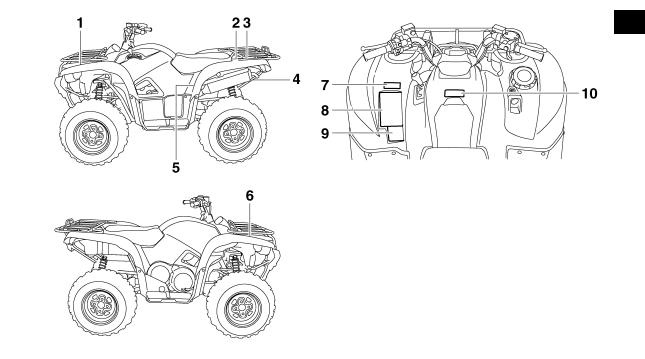
EBU17660
LOCATION OF THE WARNING AND SPECIFICATION LABELS
2
2-1
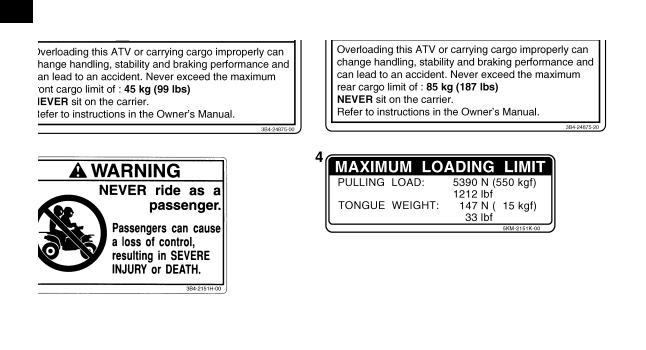
EBU17670
Read and understand all of the labels on your ATV. These labels contain important information for safe and proper operation.
2Never remove any labels from your ATV. If a label becomes difficult to read or comes off, request a replacement label from your Yamaha dealer.
2-2
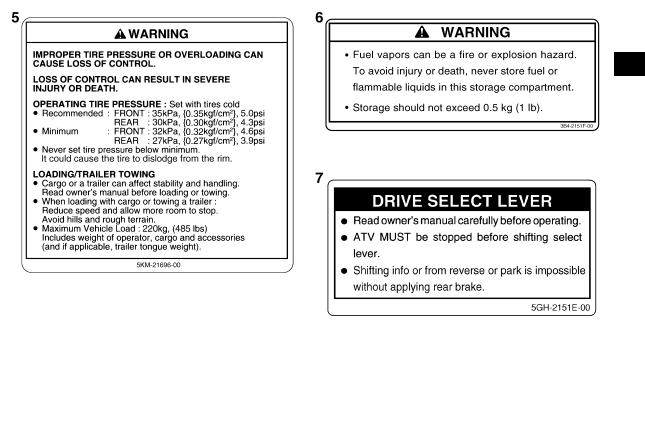
2
2-3
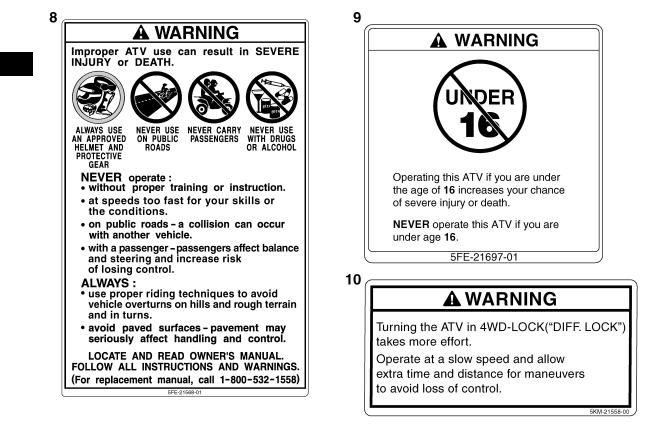
2
2-4

EBU17680
EBU17690
Left view
1.Radiator cap
2.Battery
3.Fuses
4.Air filter case
5.Spark arrester
6.Engine oil dipstick
7.Oil filter cartridge
8.Coolant reservoir
DESCRIPTION
EBU17700
Right view
3
1.Rear shock absorber assembly spring preload adjusting ring
2.Rear storage compartment and tool kit
3.Fuel tank cap cover
4.Throttle stop screw
5.Front shock absorber assembly spring preload adjusting ring
6.Spark plug
7.Brake pedal
8.V-belt case drain plug
3-1

EBU17712 |
|
|
|
Controls and instruments |
NOTE: |
|
|
|
|||
|
The ATV you have purchased may differ slightly |
||
|
from the figures shown in this manual. |
||
|
|
|
|
3
1.Drive select lever
2.Rear brake lever
3.Handlebar switches
4.Rear brake fluid reservoir
5.Multifunction meter unit
6.Front brake fluid reservoir
7.On-Command four-wheel-drive/differential gear lock switch
8.Front brake lever
9.Throttle lever
10.Front storage compartment 11.Main switch
12.Auxiliary DC jack
3-2

EBU17720
INSTRUMENT AND CONTROL FUNCTIONS
EWB00010
 WARNING
WARNING
Indicates a potential hazard that could result in |
|
|
serious injury or death. |
|
|
EBU17760 |
4 |
|
Main switch |
||
|
The positions of the main switch are as follows:
ON
All electrical systems are supplied with power. The headlights and taillight come on when the light switch is on, and the engine can be started. The key cannot be removed.
OFF
All electrical systems are off. The key can be removed.
1. Main switch
4-1
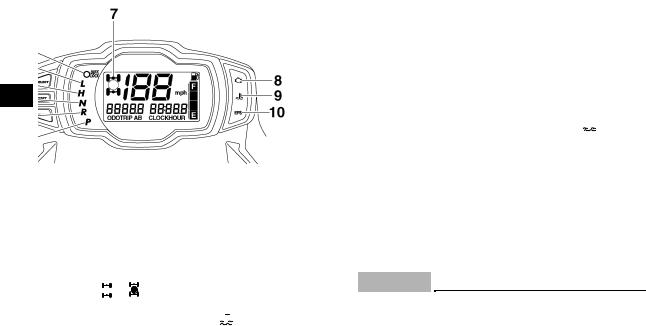
EBU26691
Indicator lights and warning lights
4
1.On-Command differential gear lock indicator light “DIFF. LOCK”
2.Low-range indicator light “L”
3.High-range indicator light “H”
4.Neutral indicator light “N”
5.Reverse indicator light “R”
6.Park indicator light “P”
7.On-Command four-wheel-drive/differential gear lock
indicator “  ”/“ DIFF. ”
”/“ DIFF. ”
LOCK
8.Engine trouble warning light “  ”
”
9.Coolant temperature warning light “  ” 10.EPS warning light “EPS”
” 10.EPS warning light “EPS”
EBU17830
Reverse indicator light “ ”
”
This indicator light comes on when the transmission is in the reverse position.
EBU17860
Neutral indicator light “ ”
”
This indicator light comes on when the transmission is in the neutral position.
EBU17900
Coolant temperature warning light “  ”
”
This warning light comes on when the engine overheats. When this occurs during operation, stop the engine as soon as it is safe to do so and allow it to cool down for about 10 minutes.
The electrical circuit of the warning light can be checked by turning the key to “ON”. If the light does not come on, have a Yamaha dealer inspect the electrical circuit.
ECB00010
CAUTION:
●The engine may overheat if the ATV is overloaded. In this case, reduce the load to specification.
4-2

●Start the engine after making sure that the warning light is out. Continuous use while the warning light is on may cause damage to the engine.
EBU27280
Engine trouble warning light “  ”
”
This warning light comes on or flashes when an electrical circuit monitoring the engine is defective. When this occurs, have a Yamaha dealer check the self-diagnosis system. (See page 4-5 for an explanation of the self-diagnosis device.)
The electrical circuit of the warning light can be checked by turning the key to “ON”. If the warning light does not come on, then go off, have a Yamaha dealer check the electrical circuit.
EBU27541
Electric Power Steering “EPS” warning light
This warning light comes on when the key is turned to “ON”, and then goes off once the engine is started. If the warning light remains on or comes on after the engine is started, the EPS system may be defective. When this occurs, have a Yamaha dealer check the EPS system.
The electrical circuit of the warning light can be checked by turning the key to “ON”. If the warning light does not come on, have a Yamaha dealer check the electrical circuit.
NOTE:
●If the engine is stopped using the engine stop switch and the key is in the “ON” position, the
EPS warning light comes on to indicate that the 4 power assistance for the steering is not functioning.
●If the steering load is too heavy (i.e., excessive steering use when the ATV is traveling at a slow speed), the power assist is reduced to protect the EPS motor from overheating.
EBU17961
On-Command four-wheel-drive/differential
gear lock indicator “ ”/“ DIFF. ”
LOCK
The On-Command four-wheel-drive indicator “  ” comes on when the On-Command four-wheel- drive switch is set to the “4WD” position.
” comes on when the On-Command four-wheel- drive switch is set to the “4WD” position.
The On-Command differential gear lock indicator
“DIFF. ” in the On-Command four-wheel-drive indica-
LOCK
tor also comes on when the On-Command differential gear lock switch is set to the “LOCK” position.
4-3

NOTE:
● Due to the synchronizing mechanism in the differential gear case, the four-wheel-drive indicator may not come on until the ATV starts moving.
● When the On-Command differential gear lock switch is set to “LOCK”, the indicator “  ” will flash until the differential gear is locked.
” will flash until the differential gear is locked.
4
EBU17970
Park indicator light “  ”
”
This indicator light comes on when the transmission is in the park position.
EBU17980
High-range indicator light “  ”
”
This indicator light comes on when the transmission is in the high-range position.
EBU17990
Low-range indicator light “  ”
”
This indicator light comes on when the transmission is in the low-range position.
EBU18001
On-Command differential gear lock indicator light “DIFF. LOCK”
This indicator light and the On-Command differential gear lock indicator in the display come on when the On-Command differential gear lock switch is set to the “LOCK” position.
NOTE:
When the switch is set to “LOCK”, the On-Com- mand differential gear lock indicator light will flash until the differential gear is locked.
4-4

EBU27291
Multifunction display
1.“CLOCK” button
2.“RESET” button
3.“SELECT” button
4.Speedometer
5.Fuel meter
6.Clock/Hour meter
7.Odometer/Tripmeter A/Tripmeter B
The multifunction display is equipped with the following:
●a speedometer (which shows the riding speed)
●an odometer (which shows the total distance traveled)
●two tripmeters (which show the distance traveled since they were last set to zero)
●a clock
●an hour meter (which shows the total time the key has been turned to “ON”)
●a fuel meter
●a self-diagnosis device
Odometer and tripmeter modes
Pushing the “SELECT” button switches the display between the odometer mode “ODO” and the trip- 4 meter modes “A” and “B” in the following order:
ODO → TRIP A → TRIP B → ODO
To reset a tripmeter, select it by pushing the “SELECT” button, and then push the “RESET” button for at least three seconds. The tripmeters can be used to estimate the distance that can be traveled with a full tank of fuel. This information will enable you to plan future fuel stops.
NOTE:
Holding in the “SELECT” button and then turning the key to “ON” switches the display between “mph” and “km/h”.
Clock mode
Pushing the “CLOCK” button switches the display between the clock mode “CLOCK” and the hour meter mode “HOUR” in the following order:
4-5

CLOCK → HOUR → CLOCK
To set the clock
1.Set the display to the clock mode.
2.Push the “SELECT” button and “RESET” button together for at least three seconds.
3.When the hour digits start flashing, push the “RESET” button to set the hours.
44. Push the “SELECT” button, and the minute digits will start flashing.
5.Push the “RESET” button to set the minutes.
6.Push the “SELECT” button and then release it to start the clock.
Fuel meter
The fuel meter indicates the amount of fuel in the fuel tank. The display segments of the fuel meter disappear from “F” (full) towards “E” (empty) as the fuel level decreases. When the “E” segment disappears and the fuel level warning indicator flashes, refuel as soon as possible.
NOTE:
This fuel meter is equipped with a self-diagnosis system. If the electrical circuit is defective, all the display segments and fuel level warning indicator will start flashing. If this occurs, have a Yamaha dealer check the electrical circuit.
1.Fuel level warning indicator
2.Fuel meter
3.“E” segment
4-6
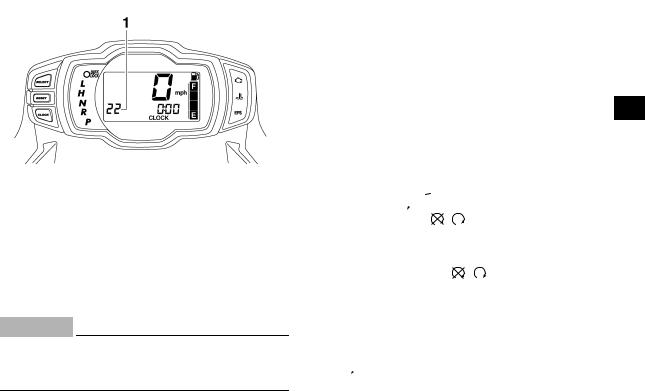
Self-diagnosis device |
EBU18060 |
|
Handlebar switches |
4
1. Error code display
This model is equipped with a self-diagnosis device for various electrical circuits.
If any of those circuits are defective, the multifunction display will indicate a two-digit error code.
If the multifunction display indicates such an error code, note the code number, and then have a Yamaha dealer check the vehicle.
ECB00810
CAUTION:
If the multifunction display indicates an error code, the vehicle should be checked as soon as possible in order to avoid engine damage.
1.Light switch “  /
/  /OFF”
/OFF”
2.Start switch “  ”
”
3. |
Engine stop switch “ / |
” |
4. |
Override switch “OVERRIDE” |
|
EBU18080 |
|
|
Engine stop switch “ |
/ ” |
|
Set this switch to “  ” before starting the engine. The engine stop switch controls the ignition and stops the engine when it is running. Use this switch to stop the engine in an emergency situation. The engine will not start or run when this switch is set to “
” before starting the engine. The engine stop switch controls the ignition and stops the engine when it is running. Use this switch to stop the engine in an emergency situation. The engine will not start or run when this switch is set to “ ”.
”.
4-7

EBU18100
Start switch “ ”
”
Push this switch to crank the engine with the starter.
ECB00050
CAUTION:
See the starting instructions on page 6-1 prior to starting the engine.
4
EBU18151 |
|
|
Light switch “ |
/ |
/OFF” |
Set this switch to “ |
” to turn on the low beams |
|
and the taillight. Set the switch to “  ” to turn on the high beams and the taillight. Set the switch to “OFF” to turn off all the lights.
” to turn on the high beams and the taillight. Set the switch to “OFF” to turn off all the lights.
ECB00040
CAUTION:
Do not use the headlights with the engine turned off for an extended period of time, otherwise the battery may discharge to the point that the starter motor will not operate properly. If this should happen, remove the battery and recharge it.
EBU18180
Override switch “OVERRIDE”
1. Override switch “OVERRIDE”
Top speed is normally limited when operating in differential gear lock. If conditions require more engine power when riding forward, push and hold this switch to override the differential gear lock speed limiting function. (See page 4-10.) Releasing the switch restores the speed limiting function.
While the override switch is pushed, the segments of the speedometer digits will appear as shown in the figure.
4-8
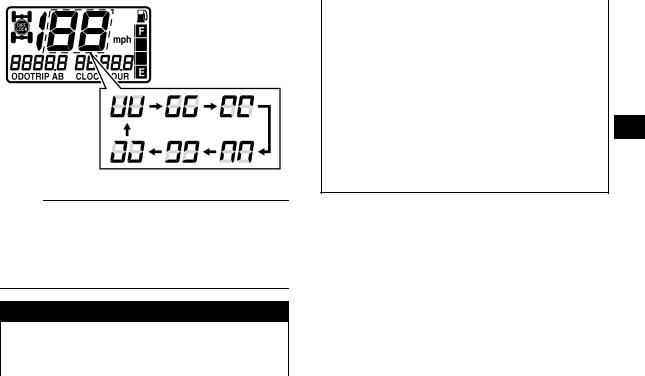
NOTE:
If the digits of the speedometer appear as shown when the switch is NOT being pushed, this could indicate a malfunction in the electrical system. In this case, take the ATV to a Yamaha dealer at the first opportunity.
EWB00110
 WARNING
WARNING
POTENTIAL HAZARD
Riding too fast while the ATV is in four- wheel-drive differential gear lock.
WHAT CAN HAPPEN
All wheels turn at the same speed when the differential is locked, so it takes more effort to turn the ATV. The effort needed to turn increases with the riding speed. You may lose control and have an accident if you cannot make a sharp enough turn for the speed you are traveling.
HOW TO AVOID THE HAZARD 4 Always ride at a slow speed when the ATV is
in four-wheel-drive differential gear lock, and allow extra time and distance for maneuvers.
EBU26632
On-Command four-wheel-drive switch “2WD”/“4WD”
This ATV is equipped with a switch to change from two-wheel drive to four-wheel drive and vice-versa. Select the appropriate drive according to the terrain and the conditions.
●“2WD” (two-wheel drive): Power is supplied to the rear wheels.
●“4WD” (four-wheel drive): Power is supplied to the rear and front wheels.
4-9

To change from two-wheel drive to four-wheel drive, stop the ATV and push the switch in to the “4WD” position. Then, the four-wheel-drive indicator “  ” comes on in the multifunction meter unit display.
” comes on in the multifunction meter unit display.
To change from four-wheel drive to two-wheel drive, stop the ATV and push the switch in to the
“2WD” position.
4
1. On-Command four-wheel-drive switch “2WD”/“4WD”
EWB00120
 WARNING
WARNING
POTENTIAL HAZARD
Changing from two-wheel drive to fourwheel drive or from four-wheel drive to twowheel drive while the ATV is moving.
WHAT CAN HAPPEN
The ATV handles differently in two-wheel drive than in four-wheel drive in some circumstances. Changing from two-wheel drive to four-wheel drive or from four-wheel drive to two-wheel drive while moving may cause the ATV to unexpectedly handle differently. This could distract the operator and increase the risk of losing control and of causing an accident.
HOW TO AVOID THE HAZARD
Always stop the ATV before changing from two-wheel drive to four-wheel drive or viceversa.
EBU18242
On-Command differential gear lock switch “4WD”/“LOCK”
This ATV is equipped with a switch allowing you to lock the differential gear when in four-wheel drive. Select the appropriate switch position according to the terrain and the conditions.
●“4WD” (four-wheel drive): Power is supplied to the rear and front wheels.
4-10
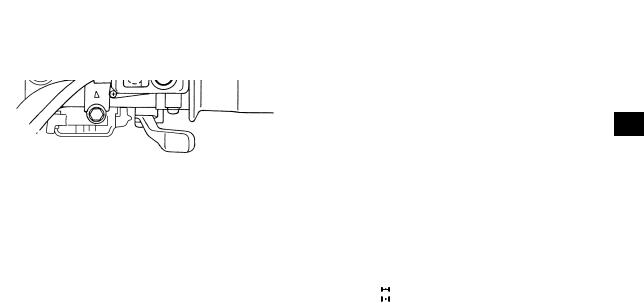
●“LOCK” (four-wheel drive with the differential gear locked): Power is supplied to the rear and front wheels and the differential gear is locked. Unlike in four-wheel drive, all wheels turn at the same speed.
1.On-Command four-wheel-drive switch “2WD”/“4WD”
2.On-Command differential gear lock switch “4WD”/“LOCK”
To lock the differential gear in four-wheel drive, make sure the On-Command four-wheel-drive switch is pushed in to the “4WD” position.
4
1.Differential gear lock lever
2.On-Command four-wheel-drive switch “2WD”/“4WD”
Stop the ATV, move the differential gear lock lever to position (a), and then push the differential gear lock switch in to the “LOCK” position. When the differential gear is locked, the differential gear lock indicator “DIFF. LOCK” will come on along with the indicator “  ” in the multifunction meter display.
” in the multifunction meter display.
4-11

4
1. On-Command differential gear lock switch “4WD”/“LOCK”
To release the differential gear lock, stop the ATV and push the switch to the “4WD” position.
EWB00091
 WARNING
WARNING
POTENTIAL HAZARD
Changing from four-wheel drive to four- wheel-drive differential gear lock or vice-ver- sa while the ATV is moving.
WHAT CAN HAPPEN
The ATV handles differently in four-wheel drive than in differential gear lock in some circumstances. Changing from four-wheel drive to differential gear lock or vice-versa while moving may cause the ATV to handle differently unexpectedly. This could distract the operator and increase the risk of losing control and causing an accident.
HOW TO AVOID THE HAZARD
Always stop the ATV before changing from four-wheel drive to four-wheel-drive differential gear lock or vice-versa.
EWB00101
 WARNING
WARNING
POTENTIAL HAZARD
Riding too fast while the ATV is in four- wheel-drive differential gear lock.
WHAT CAN HAPPEN
All wheels turn at the same speed when the differential gear is locked, so it takes more effort to turn the ATV. The effort needed to turn increases with the riding speed. You may lose control and have an accident if you cannot make a sharp enough turn for the speed you are traveling.
4-12
